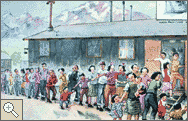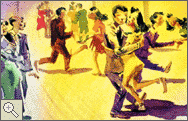|
|
 |
 |
 |
|
The Slow Return |
|
Clara Breed
-
Leaving Home
-
Home Away From Home
-
The Slow Return
-
Legacies
|
 |
 |
 |

To begin the process of moving internees out of the camps, the government issued a "loyalty questionnaire" in 1943. Two of the questions were particularly controversial. One asked the U.S.-born Nisei if they were willing to serve in the armed forces. The other asked all adults if they would renounce any allegiance to Japan.
For the immigrant Issei, answering affirmatively meant giving up the only citizenship they were allowed to hold. For the Nisei, it meant renouncing a country that was never theirs and fighting for a country in which they were not entirely welcome.
Most of those who answered no to either question were sent to a segregation camp at Tule Lake, California. Young men who answered yes began entering the service as volunteers in the 442nd Regimental Combat Team, which joined up with the Hawaiian Nisei 100th Infantry Battalion. The 100th/442nd sufferered more than eight hundred casualties in rescuing some two hundred men stranded behind German lines in the Vosges Mountains of France. For its size and term of duty, it was the most decorated unit in American history.
Early in 1945, the War Department lifted the restrictions on the West Coast and allowed the internees to go back to their homes. Most, however, chose not to leave the camps immediately.
"The news of being able to go back to California has been accepted with mingled feeling," wrote Fusa Tsumagari to Miss Breed in January 1945. "Those with property are wanting to go back, but wondering how the sentiment will be. Of course we know that good friends like you would be glad to have us back but others who do not know us or understand us may not be as glad to see us."
Those apprehensions were not baseless— there were incidents of arson, vandalism, and violence against Japanese Americans who returned to the West Coast. Moreover, as Fusa indicated, many internees had nothing waiting for them outside of the camps. They had given up their homes and had sold off their belongings quickly and cheaply before the evacuation.
Under the Evacuation Claims Act of 1948, internees received compensation of less than 10 percent of their total property losses. It wasn't until the early 1970s that a movement began in the Japanese American community to seek a fuller redress.
In 1980, Congress created the Commission on Wartime Relocation and Internment of Civilians (CWRIC). In a report issued in 1983, the CWRIC concluded that Executive Order 9066 and the subsequent internment policy stemmed from "race prejudice, war hysteria, and a failure of political leadership." In 1988, President Reagan signed the Civil Liberties Act, which granted $20,000 to each surviving internee and provided for a national apology for a "grave injustice."
The redress movement succeeded not in closing the internment episode but in clarifying it, according to Richard "Babe"Karasawa, a volunteeer at the Japanese American National Museum who spent much of his adolescence behind a fence at Poston. In 1981, he listened to many hours of emotional testimony at a CWRIC hearing in Los Angeles. It was only then that he began to come to a realization: the feeling of being a "rejected American" had been his own deepest pain.
"I hadn't been conscious of what was driving me all my life," he said. "My parents stressed upon us that we had to work hard and always do the best we could. I always wanted to be a good American. I felt I had to be extra good."
Issei and Nisei
In the Miss Breed letters, the reader often encounters the words Issei and Nisei. Simply put, Issei means the first generation of Japanese in America and Nisei means the second. The words are so commonly used among Japanese Americans that they have entered the English language, along with Sansei and Yonsei, the words for the third and fourth generations.
The distinctions between the Issei and the Nisei were reinforced by U.S. law. The Act of February 18,1875, barred the Issei and other Asian immigrants from citizenship. The Nisei were U.S. citizens by virtue of their birth in America.
Miss Breed's correspondents, all of them Nisei, sometimes wrote about the cultural differences between themselves and their elders. Fusa Tsumagari, for instance, told of a talent show at Poston that turned out to be a disappointment to her and her friends.
"We went, and were rather disgusted," she said. "They had half American program and half Japanese. They would have a song, 'Sleepy Lagoon,'; then next on the program would be a Japanese dance, and so on through the whole program. We had been expecting all American songs and dances and skits. We expected them to save all the Japanese songs and dances for the 'Issei Night.'"
|
 |
 |
 |
 |

The 100th Infantry Battalion in Northern Italy.
|
 |
 |
 |
 |
 |
 |

Progress after One Year--The Mess Hall Line by Kango Takamura (Manzanar, 1943).
|
 |
 |
 |
 |
 |
 |

Recreation Barrack Dance by Gene Sogioka (Poston).
|
 |
 |
 |
|




|
|
|

